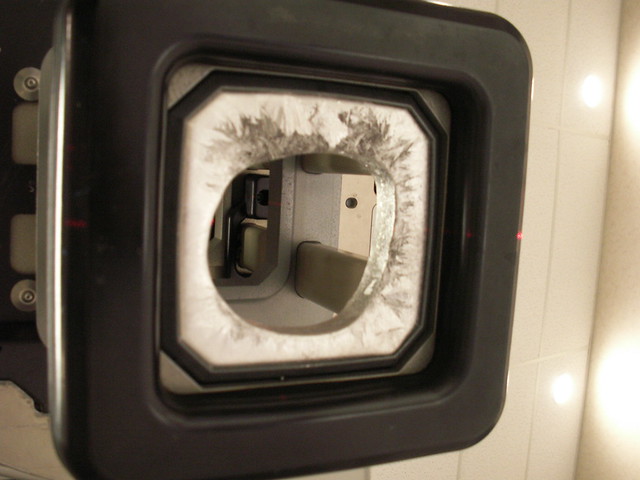Rite of Passage in Here Be Dust
- Dec. 7, 2014, 1:33 a.m.
- |
- Public
On Friday, nine months and one day after I received my diagnosis, I completed “active treatment” (defined as surgery/chemo/radiation) for breast cancer.

(To read the slips of paper in the RBOI Support Kit, click here.)
On Tuesday (before radiation treatment #30 out of 33) I had photographed the plastic cast tailored to my body shape. This cast had held me in the same position through all 33 treatments:

My head rested in the center depression. My left arm rested in the curved track and I held onto the white peg.
This final radiation week involved the “boost” phase of my treatments: radiation aimed specifically at my tumor bed. (More info here.)

This cage is attached to the linear accelerator. The cage holds a small mold whose opening size matches the new markings made on my breast, to guide the electrons used in the boost. Both the mold and the plastic cast can be recycled and reused.
This last phase of radiation treatment went considerably more quickly than my earlier treatments. During each of the five boost days I received a single zap to just one spot defined by the mold, rather than a series of zaps to 11 separate fields.

Many thanks go to my radiation team and the caring people I’ve been privileged to meet throughout this process. I received my boost radiation in a different room than the rest of my treatments, though some facilities use the same machine for both.
As I type this entry I sit slathered in Vitamin A&D ointment. Much of my left breast now looks as though it has received a bad sunburn. The blistering (shown here) is the worst of it. Even so, at most I rank my pain at a 3 on a scale of 1-10, and most of the time it stops at 2. I am now free to apply ointment whenever and wherever I want. In the past I had to wait until after each treatment before re-application and I had to preserve my breast markings.
I will also document the healing process. My radiation oncologist made the excellent point that showing the healing is also important.
I have now begun to take Arimidex (anastrazole) and will continue for at least five and likely ten years.

Arimidex is an aromatase inhibitor (AI). My tumor had been hormone receptor-positive. Even though I am post-menopausal, my adrenal glands still produce estrogen. Estrogen is food for the type of cancer I’ve been fighting; I am on the AI to try to prevent cancer recurrence.
According to Breastcancer.org, “Aromatase inhibitors work by blocking the enzyme aromatase, which turns the hormone androgen into small amounts of estrogen in the body. This means that less estrogen is available to stimulate the growth of hormone-receptor-positive breast cancer cells.”
I am also taking calcium because bone loss is a potential side effect of Arimidex. I learned at my breast cancer support group that taking Arimidex before bed helps guard against other potential side effects like bone and muscle pain. There’s variability here, too – a friend of mine had experienced no negative side effects from Arimidex at all over the five years she had taken it.
I’ve also read accounts like the one from Nancy Stordahl, who writes, “Shortly after I began taking Arimidex®, sleep issues due to leg pain and leg cramps (to name a couple) started up. Aches and pains in my joints/bones became significantly bothersome 24/7. I began to feel like an eighty year old woman when trying to get out of my car, rise from a chair, sit through a movie or just move around period. In addition, quite quickly after beginning on the drug I gained fifteen pounds (am I actually admitting this so publicly?) Last winter I was diagnosed with osteopenia (bone health previously was excellent) and this spring it became nearly impossible for me to walk to the stop sign at the end of my street because of the crippling effect on my feet and toes. Before the drug, I was used to walking two to four miles a day by the way.”
Obviously I hope my experience is more like my friend’s. I have also read that in many cases side effects like bone and muscle pain lessen considerably after the first three months or so.
Then there’s the recent finding reported in the Journal of Clinical Oncology that aerobic exercise and strength training decrease pain from AIs. I’ve been exercising aerobically throughout my treatment and am slowly returning to strength training (in a way that does not court lymphedema), so I hope that works in my favor.
The bottom line is that endocrine therapy is like any other cancer treatment, in that no two experiences are alike and they can cover a broad range of possibilities. I’ll take each day as it comes.
My hair regrowth continues:

On Thursday I saw my regular oncologist and had follow-up blood work done. Only a couple of readings remain abnormal. My white blood cell count has dropped back into the low range, likely due to the radiation. But my protein is finally in the normal range! Next week I’ll have a MUGA scan to gauge any effect that chemo might have had on my heart; it follows up the scan that had been done prior to chemo. A follow-up PET scan will have to wait until my body has healed from radiation, since radiation can confound the PET results.
On Saturday M and I attended her MS support group meeting for the first time in several months. Sometimes she has needed more sleep; sometimes I’ve needed it. This time we had both gotten sufficient rest and had enough energy to get out and about.



Loading comments...